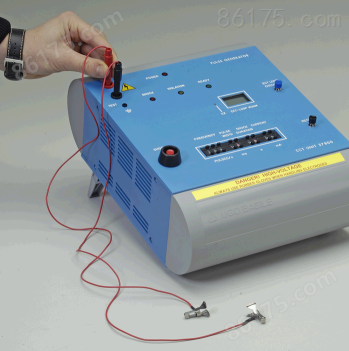组织损毁仪
产品简介
详细信息
详细介绍
电损毁仪于神经化学和神经药理学研究。恒定的电流能够确保测量结果有良好的重复性和由药物对大脑皮层或大脑皮下层区域引起电休克进行精确测定。持续的电流等级通过反馈电路形成该电路还可调节动物间不同的阻抗。动物阻抗能够被预测试和显示并且在阻抗太高而不能发出理想的电流信号时会自动警报提示。
角膜和耳使用标准的电极也可根据实验人员的需要定制电极。有逆变器、双相单元、双极型逆变器可选。
主要技术参数
| Current Range | 10 µA to 99 mA |
| Max Electrode Resistance | 20 MO (10 µA) down to 2KO (100 mA) |
| Pulse Duration | 1-99 sec. or manually controlled |
| Compliance Volatage | 200V |
| Shipping Wt.: | 6 lbs. (2.8 kg) |
| Dimensions (cm): | 25 x 15 x 11 |
可根据需要选择电休克仪
电休克仪
Electroconvulsive Device is designed for inducing convulsions in research animals. Consistent reproducible current levels are produced by feedback circuitry that adjust for variance in impedance of the contact from animal to animal.
主要技术参数
| Frequency | 1-299 pulses/sec. |
| Shock Duration | 0.1-9.9 sec. |
| Compliance Voltage | 2.5 kV |
| Current Range | 1-99mA |
| Output Impedance | 0 Ohm to 25 kOhm |
| Pulse Width | 0.1 - 0.9 ms. |
| Pulse Rise and Fall Time | 20 µs |
| LED Display | 0 to 199 kOhm |
相关引用文献
S.M. Fortin et alia“Sampling Phasic Dopamine Signaling with Fast-Scan Cyclic Voltammetry in Awake, Behaving Rats” Current Protocols in Neuroscience, UNIT 7.25, published online 5 Jan 2015
§ V.D. Campese et alia“Lesions of lateral or central amygdala abolish aversive Pavlovian-to-instrumental transfer in rats” front Behav Neurosci. 8161, 2014
§ M.G. McCue et alia“Medial Amygdala Lesions Selectively Block Aversive Pavlovian–Instrumental Transfer in Rats” front Behav Neurosci. 8329, 2014
§ Stroobants et alia“PIncreased gait variability in mice with small cerebellar cortex lesions and normal rotarod performance” Behav. Brain Res. 24132-37, 2013
§ L.B. Cruz et alia“Effect of the bone marrow cell transplantation on elevated plus-maze performance in hippocampal-injured mice” Behav. Brain Res. available online Apr. 2013
§ M.B. Gomes et alia“Glucose levels Observed in Daily Clinical Practice induce Endothelial Dysfunction in the Rabbit Macro- and Microcirculation” Fund. & Clin. Pharmacol. 18 (3), 2004
§ C. Hamani et alia“Bilateral Anterior Thalamic Nucleus Lesions and High-frequency Stimulation Are Protective against Pilocarpine-induced Seizures and Status Epilepticus”Neurosurgery, 54 (1)191-197, 2004
3007536035

